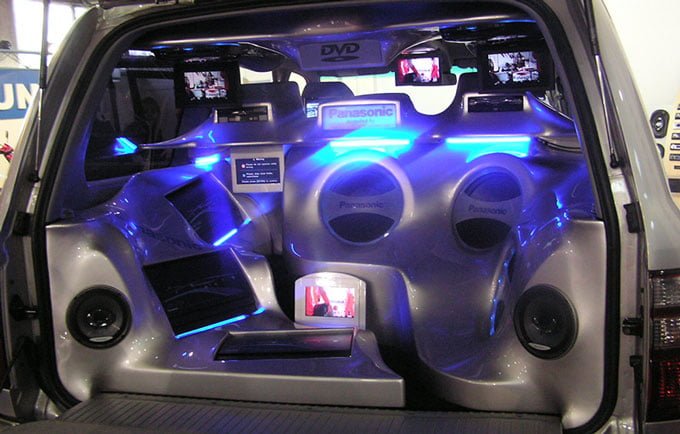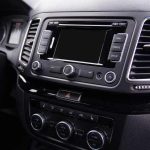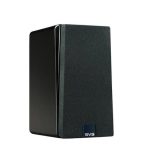A car audio system sounds best when everything is properly set. Integrating a crossover into your car would even make it sound better. So how does a crossover work? What are crossover frequencies? And how would you set crossover frequency for your car audio system? This article has all those answers. Read on to know everything about crossover frequencies for car audio systems.
What is a crossover and how does it work?
A crossover works by breaking sound into different component frequencies. Each crossover frequency is then sent to specific speaker drivers for the best audio performance. Basically, sound comprises different frequencies. Different speakers are designed to reproduce some frequencies better than others. For instance, tweeters reproduce high frequencies, mid-range speakers reproduce mid-range frequencies, and woofers are best at reproducing low frequencies.
Crossovers are either passive or active. Passive crossovers usually filter out unwanted audio frequencies between an amplifier and the connected speakers. Thus, passive crossovers are installed between an amplifier and speakers. Some speakers come with inbuilt passive crossovers. Passive crossovers are easy to work with and they don’t require an external source of power. They’re powered by the signal that passes through them. Signals meant for the tweeter travel through capacitors and those meant for the woofer travel through an inductor.
On the other hand, active crossovers are more complex to work with than passive ones. Active crossovers require their own source of power. Active crossovers differentiate different frequencies before they reach the amplifier. As such, active crossovers are installed between the sound source and the amplifier. The amplifier is then connected to the speakers. Thus, using active crossovers require using an amplifier with multiple outputs. Active crossovers are more expensive than passive ones.
While setting crossover frequency, you’ll apply a low-pass or high-pass filter and a crossover slope. Low-pass filters are used on subwoofers to filter out high frequencies whereas high-pass filters are used on midrange speakers and tweeters to filter out low frequencies. The crossover slope is applied to determine the steepness of the filtering ability of the crossover. Low-pass and high-pass filters are denoted in hertz (Hz) whereas slope is denoted in decibels (dB).
Most car audio systems use a 12 dB or 24 dB slope. A 12 dB slope is most suitable for sedans and coupes that have subwoofers installed in their trunk. A 24 dB slope is ideal for more open cars such as SUVs, wagons, and hatchbacks.
How to Configure Crossover Frequency for Car Audio Systems
Now that you know what a crossover is and how it works, we can look at how to configure crossover frequency in a car audio system. It’s important to know how to configure crossover frequency for different car audio system setups. Here’re the different car audio setups and how to configure crossover frequency for each:
Audio setup 1: Front component speakers, rear coaxial speakers, and a sub
In this car audio setup, the front speakers are component speakers whereas the rear speakers are coaxial speakers. The setup also has a subwoofer. In this case, the front component speakers and the subwoofer will need a crossover. The rear coaxial speaker may have its own inbuilt active crossover, but most coaxial speakers lack a passive crossover. As such, you’ll definitely need to add a passive crossover to this setup. You’ll need a high-pass filter to filter low frequencies and a low-pass filter to filter the high frequencies. The best crossover frequencies for this setup will be:
- Sub: Set the low-pass filter to 80 Hz (with a slope of 12/24 dB)
- Rear coaxial drivers: Set the high-pass filter to 80 Hz (with a slope of 12/24 dB)
- Front component drivers: Set the high-pass filter to 80 Hz (with a slope of 12/24 dB)
These crossover frequencies are best for speakers that measure 5.25 inches or more. In case you’re using smaller speakers, then you should set a higher frequency than the above frequencies. You can start setting the frequency at 300 Hz and then reduce it slowly as you listen to any distortion in the midrange. In case of any distortion after lowering the frequency, then increase the frequency slowly until everything is clear.
Audio setup 2: Front component speakers and a subwoofer
In this setup, you’ll need to have passive crossovers to divide the frequencies to drive the midrange and tweeters. This will need using a high-pass filter. The high-pass filter will filter low frequencies that a midrange driver cannot handle. The passive crossover will also separate frequencies between the mid and high-frequency speakers. If the component speaker is a 3-way setup, the crossover will separate the frequencies and ensure the high frequency, mid-frequency, and low-frequency drivers get their ideal frequencies. As for the sub, you’ll need to apply a low-pass filter to filter high frequencies towards it such that it will only reproduce low frequencies. For this audio setup, use these crossover frequencies:
- Sub: Set the low-pass filter to 80 Hz (with a slope of 12/24 dB)
- Front component drivers: Set the high-pass filter to 80 Hz (with a slope of 12/24 dB)
These configurations also apply for speakers larger than 5.25, just like in “Audio Setup 1” above. For smaller speakers, start with a higher frequency like mentioned previously until you get the best sound without distortion.
Audio setup 3: 2-way front component speakers and a subwoofer
If you’re using a combination of 2-way front speakers and a subwoofer, then you’ll need to apply high-pass filters for the tweeter, band-pass filters for the midrange speaker, and a low-pass filter for the sub. In this setup, use these crossover frequency configurations:
- Sub: Set the low-pass filter to 80 Hz (with a slope of 12/24 dB)
- Midrange: Set the band-pass filter to 80 Hz high-pass filter and 5 kHz low-pass filter (with a slope of 12/24 dB)
- Tweeters: Set the high-pass filter to 5 kHz (with a slope of 12/24 dB)
Audio setup 4: 3-way front component speakers and subwoofer
A car sound system that comprises 3-way front component speakers and a subwoofer will need a high-pass filter for the high-frequency drivers, a band-pass filter for the midrange driver, and a band-pass filter for the woofer, and a low-pass filter for the sub. Use the following crossover configuration:
- Sub: Set the low-pass filter to 80 Hz (with a slope of 12/24 dB)
- Woofers: Set the band-pass filter to 80 Hz high-pass filter and 500 Hz low-pass filter (with a slope of 12/24 dB)
- Midrange: Set the band-pass filter to a 500 Hz high-pass filter and 5 kHz low-pass filter (with a slope of 12/24 dB)
- Tweeters: Set the high-pass filter to 5 kHz (with a slope of 12/24 dB)
Audio setup 5: 2-way front speakers, rear speakers, and a subwoofer
If you’re using a combination of 2-way front speakers, rear speakers, and a subwoofer, then use this crossover configuration:
- Rear drivers: Set the high-pass filter to 80 Hz (with a slope of 12/24 dB)
- Front midrange drivers: Set the band-pass filter to 80 Hz high-pass filter and 5 kHz low-pass filter (with a slope of 12/24 dB)
- Front tweeters- Set the high-pass filter to 5 kHz (with a slope of 12/24 dB)
Audio setup 6: 3-way front component speakers, rear speakers, and a subwoofer
A car sound system that comprises of 3-way front component speakers, rear speakers, and a subwoofer should use the following crossover frequency configuration:
- Sub: Set the low-pass filter to 80 Hz (with a slope of 12/24 dB)
- Front woofers: Set the band-pass filter to 80 Hz high-pass filter and 500 Hz low-pass filter (with a slope of 12/24 dB)
- Front midrange drivers: Set the band-pass filter to 500 Hz high-pass filter and 5 kHz low pass filter (with a slope of 12/24 dB)
- Front tweeters: Set the high-pass filter to 5 kHz (with a slope of 12/24 dB)
Who needs to install a crossover for their car audio system?
If you want to enjoy the best sound quality in your car, then you definitely need a crossover. While many modern stereos and coaxial speakers come with inbuilt crossovers, you might want to add a standalone car crossover for enhanced crossover frequency output.
In case your car only uses coaxial speakers, then you can do without a crossover. Full range coaxial speakers have their inbuilt crossovers that filter frequencies accordingly. However, you should install a crossover in case you want to add a subwoofer, components speakers, and an amplifier to the system. You might require multiple crossovers in case you want individual amps to power specific speakers. For instance, if you want one amp to power the subwoofers and another amp to power the component speakers and tweeters, then you’ll need two crossovers.
If you need a simpler setup, you can invest in a car amplifier that has an inbuilt crossover. The high pass filters that come with the inbuilt crossover will drive the tweeters whereas the subwoofers will be driven by the low-pass filter. As such, you won’t have to install a standalone crossover, making the setup less complicated to install.
Conclusion
Setting up crossover frequency for car audio systems is something you can do by yourself. If you’re DIY handy, you can install a car crossover by yourself and use this guide to configure the crossover frequencies. The crossover frequencies discussed here should only be used as a guide on where to start. It’s not a must to use them exactly the way they are in this guide. You can still change the frequencies according to your personal preferences. Just use your ears when configuring the frequencies until you get the best sound according to your preferences.
Michael Evanchuk is a San Francisco-based sound engineer with 20 years’ experience installing, troubleshooting, and repairing commercial, automotive, and household sound equipment. Evanchuk owns an auto stereo center, where he offers highly competitive car audio installation and repair services. He has written dozens of articles on different sound engineering topics, all of which have been published in leading journals, blogs, and websites.





